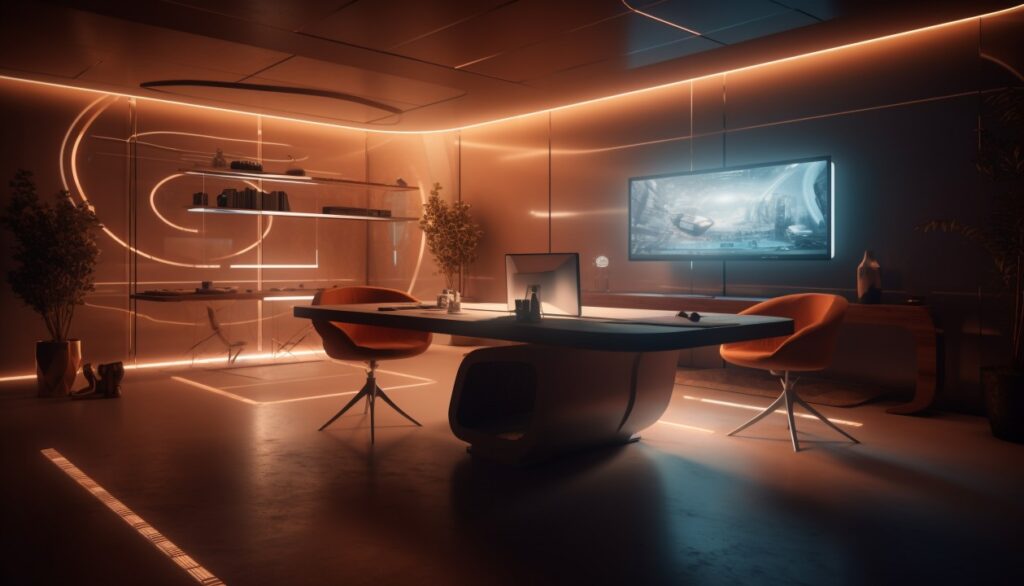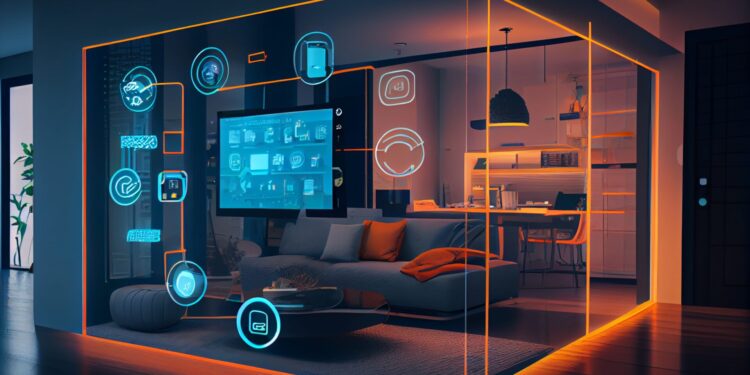AI interior design leverages cutting-edge technology to revolutionize the way we conceptualize and create living spaces, merging creativity with efficiency to craft personalized, functional, and visually stunning environments. In recent years, artificial intelligence (AI) has revolutionized various industries, and interior design is no exception. With the integration of AI technologies, interior designers are unlocking new possibilities, enhancing creativity, and streamlining processes. Here are 10 genius ideas from the world of AI interior design that are reshaping the way we think about our living spaces.
Personalized Recommendations in AI interior design
Personalized recommendations in AI interior design are a game-changer, offering homeowners tailored suggestions that align with their unique tastes and lifestyles. By harnessing the power of AI algorithms, these recommendations go beyond generic suggestions, taking into account individual preferences, past design choices, and even social media activity. Whether it’s selecting furniture styles, color palettes, or decor accents, AI analyzes vast amounts of data to offer personalized options that resonate with each homeowner’s personality and vision for their space. This level of customization not only enhances the overall design experience but also ensures that every detail reflects the homeowner’s distinct style, creating spaces that feel truly personalized and inviting.

Virtual Room Design
Virtual room design is a game-changer in the world of AI interior design, offering unparalleled convenience and creativity to both designers and homeowners. With this technology, individuals can step into a digital realm where they can experiment with different furniture arrangements, color schemes, and decor options without any physical constraints. From the comfort of their homes, users can visualize how their space will look with various design elements, allowing for informed decision-making and eliminating the guesswork often associated with traditional design methods. Whether planning a complete room makeover or simply rearranging existing furniture, virtual room design tools provide a realistic preview of the final outcome, empowering users to bring their vision to life with confidence and precision.
Smart Lighting Solutions
Smart lighting solutions are revolutionizing the way we illuminate our spaces, offering an unprecedented level of control and customization. Illuminate your home with every light on by embracing smart lighting solutions that automatically adjust to your preferences and the natural rhythms of your day. By leveraging artificial intelligence algorithms, these systems can automatically adjust lighting levels based on factors such as time of day, natural light exposure, and user preferences. Whether it’s dimming the lights for a cozy evening at home or brightening them to simulate daylight for a productive work environment, smart lighting solutions cater to the specific needs and desires of occupants. Moreover, these systems contribute to energy efficiency by intelligently managing light usage, ultimately reducing electricity consumption and lowering utility costs. With smart lighting, users can create the perfect ambiance for any occasion while also promoting sustainability and conservation.
Space Planning Optimization
Space Planning Optimization is a crucial aspect of interior design, and with the help of AI, it has reached new heights of efficiency and effectiveness. By leveraging advanced algorithms, AI analyzes floor plans and room dimensions to suggest optimal furniture placements and traffic flow patterns. This ensures that every square foot of space is utilized to its fullest potential, maximizing functionality and enhancing the overall aesthetic appeal of the room. Whether it’s arranging furniture in a living room for optimal conversation flow or optimizing workspace layouts for productivity, AI-powered space planning tools streamline the design process and help create spaces that are both beautiful and practical.
Style Recognition and Matching
Style recognition and matching is a cutting-edge application of artificial intelligence in interior design, revolutionizing the way designers and homeowners curate their spaces. Leveraging advanced computer vision technology, AI algorithms can analyze images of interior design styles, accurately identifying key elements such as furniture styles, colors, patterns, and textures. This enables users to effortlessly discover decor items that complement their desired aesthetic, whether it’s contemporary, traditional, minimalist, or eclectic. By automating the process of style recognition and matching, AI streamlines the search for cohesive design elements, saving time and eliminating guesswork. Whether seeking inspiration or shopping for specific pieces, AI-powered style recognition tools are invaluable assets for creating harmonious and visually stunning interiors.
Material Selection Assistance
Material Selection Assistance is a game-changer in the realm of interior design, thanks to the integration of AI technology. This innovative tool empowers designers and homeowners alike to navigate the vast landscape of material options with ease and confidence. By leveraging AI algorithms, material selection assistance tools take into account various factors such as durability, cost, sustainability, and style preferences to offer tailored recommendations. From flooring and countertops to fabrics and finishes, these tools provide invaluable insights, helping users make informed decisions that align with their design goals and practical needs. Whether seeking timeless elegance or contemporary flair, material selection assistance ensures that every element chosen for a space contributes to its aesthetic appeal, functionality, and longevity.

Real-Time Feedback
Real-time feedback in the realm of AI interior design is a game-changer, offering designers and homeowners instant insight into design decisions. Leveraging augmented reality (AR) technology, real-time feedback allows users to visualize proposed changes within their space immediately. Whether it’s experimenting with different furniture arrangements, testing out paint colors, or exploring various decor options, this interactive experience provides invaluable clarity and confidence. Designers can quickly iterate on ideas, and clients can make informed decisions on the spot, fostering collaboration and expediting the design process. Real-time feedback empowers stakeholders to see the impact of design choices firsthand, ensuring that every detail contributes to the overall vision of the space.
Predictive Maintenance
Predictive maintenance utilizes advanced AI algorithms to anticipate potential issues with interior features such as HVAC systems, appliances, and lighting fixtures. By analyzing data collected from smart home devices, these algorithms can detect patterns and anomalies that indicate impending failures or maintenance needs. This proactive approach allows homeowners to address issues before they escalate, minimizing downtime and preventing costly repairs. By leveraging predictive maintenance, homeowners can enjoy greater peace of mind knowing that their interior systems are continuously monitored and optimized for efficiency and reliability.
Biophilic Design Integration
Biophilic design integration involves incorporating elements of nature into interior spaces to promote a sense of well-being and connection to the natural world. By introducing elements such as natural light, indoor plants, water features, and organic materials, biophilic design seeks to create environments that mimic outdoor settings, fostering a sense of calmness and rejuvenation. This approach is rooted in the understanding that humans have an innate affinity for nature, and by bringing elements of the outdoors indoors, we can improve mental health, productivity, and overall quality of life. Biophilic design integration not only enhances the aesthetic appeal of interior spaces but also contributes to creating healthier and more sustainable environments for occupants to thrive in.
Sustainable Design Solutions
Sustainable design solutions harness the power of AI-driven analytics to prioritize environmentally conscious choices throughout the interior design process. By analyzing data on materials, energy consumption, and construction practices, AI algorithms help designers make informed decisions that minimize the ecological footprint of each project. From selecting sustainable materials such as reclaimed wood and recycled fabrics to integrating energy-efficient appliances and green building techniques, sustainable design solutions promote responsible stewardship of resources and reduce the environmental impact of interior spaces. By embracing sustainability as a core principle, AI interior design not only creates beautiful and functional environments but also contributes to a more sustainable future for generations to come.
Conclusion
In conclusion, the fusion of artificial intelligence with interior design represents a groundbreaking evolution in how we conceptualize and execute living spaces. The 10 genius ideas highlighted demonstrate the immense potential of AI to enhance personalization, efficiency, sustainability, and overall well-being within our homes. By harnessing AI-powered tools for personalized recommendations, virtual room design, smart lighting solutions, and more, designers and homeowners alike can embark on a journey of creativity and innovation. As AI technologies continue to advance, the possibilities for creating inspiring and functional interiors will only expand, paving the way for a future where our living spaces are not just aesthetically pleasing, but also deeply reflective of our individual lifestyles and values. Embracing these AI-driven innovations promises to redefine the way we inhabit and interact with our domestic environments, ushering in a new era of design excellence and user-centricity.








Comments 2